When you go out wandering, sometimes you find hidden treasures, and sometimes you just get sore feet. Saturday, I got both.
My first adventure of the weekend was to walk from BLCU to Tiananmen Square. After checking Google maps to get a general idea of how to get there, I set out walking to see what I could find. One of my favorite ways to explore a city is on foot. When you forego the comfort of a taxi or even the subway, you get to see how people live, and you don’t just see the parts of the city that every other tourist sees. Of course, when you walk around in places that don’t get many tourists, you get lots of curious stares. Especially from small kids. In Beijing, some of the kids are not sure what to think when they see a tall, blondish foreigner strolling by. I think that while I was walking yesterday, I heard one shout “Look mom! A foreigner!” (Don’t quote me on that though, my Chinese isn’t that good yet. Just ask my listening comprehension teacher).
It was about 10:30 in the morning and the air was still fairly cool at the start of the walk.. There was still a gray haze hanging over the city that was keeping out some of the sun’s heat. Over the next several hours, the sun would push through and I would find myself choosing streets by the shade they provided.
Beijing has several different types of haze in the summer time. One is the gray morning fog/haze. This is essentially a quasi-fog that is common in the mornings here, even when the temperature is quite high. Sometimes in the afternoon this burns off and the weather turns out very nice. If this type is not too heavy, it can turn into the “electric white” haze that casts a bright white glow over everything.
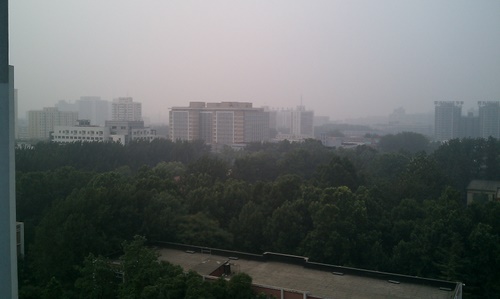 A nice gray morning
A nice gray morning
The second type of haze is the charcoal gray haze caused by soot from power plants and other sources. This is the haze that coats your lungs and gives you the Beijing cough. It is the haze that turns your spit gray when you hack something up. It is the haze that, much like a cigarette, takes a few minutes off of the end of your life with each breath. When this one gets bad, you pray for a thunderstorm to come through and wash clean the air.
Beijing also has a nice type of brown smog haze that is similar to that of Los Angeles and other major cities in the world. There are thousands of buses on the streets and factories in the surrounding areas that produce the compounds that cause smog. In addition, large trucks move goods around the city at night and the number of cars on Beijing’s streets is rapidly increasing. These all combine to number of cars on the road create a thick smog blanket. The smog becomes especially cumbersome when the air is stagnant for a few days. Again, a good thunderstorm or even a windy day improves the air significantly, at least for a while.
The fourth type of haze is one that I have not personally experienced here yet. It is the bright yellow-red haze of a dust storm. My friend Jake, who has been living here since February, tells me this one is the most imposing of all of the hazes. During the spring, winds from the northwest sweep across the Mongolian desert, carrying sand and topsoil from millions of acres and depositing it on Beijing and the surrounding areas (apparently, it travels as far as Korea too). The dust hangs in the air, slowly sifting down onto cars and bikes and streets. It invades your eyes and nose, coating your mouth with a metallic taste from all the minerals in the air. Wearing a mask helps you breathe more easily, but the dust gets into your ears and eyes and leaves everything with a fine layer of dust. Nothing feels clean. When the rains do come following the dust storm, the dust turns to mud and sticks to everything. I am not sorry I missed this one. I have a feeling it would be pretty miserable to be a Beijinger during the dust storms of the spring.
When I wander, I try to avoid looking like a tourist (no easy task for me in Beijing. ha ha) and I try to avoid getting lost. I don’t mind getting lost so much (I got completely turned around the other night and thought I was going to have to get a taxi) as I don’t like reaching dead ends and having to turn around. In the newer parts of Beijing, getting lost on dead end streets is not too much of a problem. In the older parts, however, you never know for sure if the street you turn down will have an exit or not. Also, many neighborhoods have gates and I always wonder when I go through one if I will have to come back out the same way. These gates are a salient feature of Beijing. Gates are everywhere. My University has five of them. There are gates to keep cars out, gates to keep bikes out and gates to keep everyone out. Parks have them, as do schools, neighborhoods and companies. Everywhere you go, except for on the main streets, you find another gate. They are usually open, but if the government ever decided to stop the flow of people from place to place, they could decree that all gates be shut and—Done! No one could get anywhere.
Walking southward from BLCU, I stayed along a main road for a while. BLCU is outside the 4th Ring road in Beijing and after about 20 minutes, I crossed this major artery and turned west to follow it for a while. I soon got tired of listening to the cars, so I took a right and plunged back into Beijing’s neighborhoods.
One of the interesting things about walking so far is that you get to cross through neighborhoods with varying levels of income. I passed through rich, poor and middle class neighborhoods. The nicest neighborhoods had apartments that were as nice as any you would find in Portland’s Pearl District. There were many fancy shops, some with western brands like Nike or Coach. The middle class neighborhoods were filled with people out shopping or strolling and the shops were almost exclusively Chinese shops. The poorer neighborhoods looked like China’s economic miracle had not quite reached them yet. They were full of large apartment buildings that had been neglected over time, and you could tell that less care was taken to keep some of the trash off of the street. I don’t think these were the places where China’s new middle class is moving.
After walking for an hour and a half, I found my first treasure. I had turned down a small street that turned into a long, narrow alley. On the right side was a brick wall painted gray. To the left, a long row of low, single-story brick houses. When I entered the street, I couldn’t see the opposite end, since it curved slightly to the right. I was afraid that I was going to have to turn around, but one of the rules of wandering is that you have to keep going until you confirm the dead end, so I kept on. I passed one older gentleman who was separating fruits into a pile to sell later. Sometimes you get hand signals from people telling you to turn around, but he didn’t pay me any attention. I walked a little further, to where I could see around the bend and—Yeah!—there was an open wrought-iron gate at the far end. No backtracking this time.
As I reached the gate, I was almost shocked to see what was in front of me. I had stumbled across an oasis in the center of Beijing, with lush green grass, abundant shade and a small lake. You couldn’t even hear the traffic. Even more surprisingly, there were very few people in the park, a luxury in a city of 15 million people. It was as if I had stumbled into a secret place that only a few locals know about. Unsurprisingly, I was the only Westerner in the park. Lotus flowers and hyacinths floated lazily on the lake, and at just to the south of the lake, there was a fountain that had been built to resemble some of the architecture you would find in Rome, complete with Corinthian columns. The park, 认定胡公司,was just the thing I needed to refresh myself before continuing my journey to Tiananmen. It would have been nice to stay a bit longer, but Tiananmen Square was still a long ways away. I left the park with plans to return, snapping a picture of the name of the park so that I could find my way back. Hidden treasures like this are exactly the reason that I go wandering.
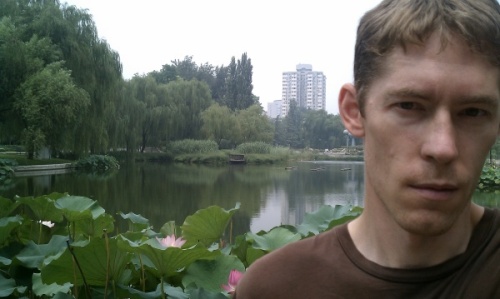 Peace in the City
Peace in the City
After a few more zigs and zags (and no backtracking!), it became obvious that I was reaching the tourist areas of town. The sidewalks started filling up with tour groups wearing the same colored baseball hat or scarf, ambling on behind guides with their flags held high in the air. I passed by Beihai park (one of Beijing’s most famous) and the crowds became larger. The streets became a dense forest of tour buses and it was difficult to walk without bumping into people or getting stuck behind a slow-moving horde that filled up the entire sidewalk.
I finally made it to the outside of the forbidden city, which was just a madhouse. People were hawking trinkets, water and slices of some type of bright yellow melon on a stick, freshly cut. My feet were pretty tired by this point and unfortunately, I turned right instead of left when I reached the city walls. I knew about where I was, but instead of choosing the short way to Tiananmen, I picked the long way. It’s my tradition to take at least one wrong turn on every trip, so this was nothing new. My feet weren’t happy about it though. I was wearing my Chaco sandals without socks, and I could feel a blister forming on the arch of my left foot. I was ready to get to Tiananmen.
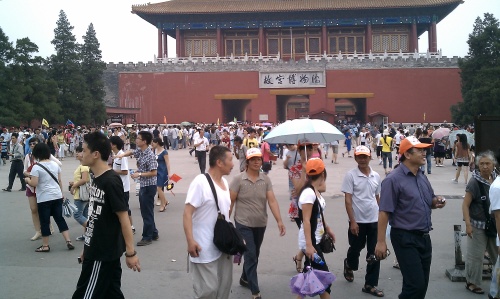 I'm glad I'm not going in there. . .
I'm glad I'm not going in there. . .
When I finally reached Changan Lu, the main avenue in central Beijing, I paused to look at the dark blue egg known as the Beijing Opera House and watch the traffic pass by. While I was standing there, an American woman approached me and asked where the National Museum was. I was proud of myself because I could confidently point it out to her. After she left, I subsequently entered a subway station, with the intention to cross the boulevard. Underground, I got turned around and came up a couple hundred yards to in the opposite direction of where I wanted to go. . . . on the same side of the street where I started. I sighed. Pride cometh. . . .
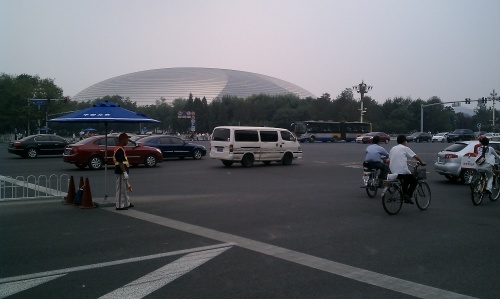 The Opera House
The Opera House
Back up above ground, I humbly made my way to Tiananmen Square. I love coming up out of the underground passageway that leads to the square. you step out into the open space and you feel like you can see forever. The square is one of my favorite places in Beijing, even though it is the least hidden of all. Obviously, I don’t have to tell you that if you ever come to Beijing you should go to the square. I appreciate its vastness and enjoy watching tourists of all types taking pictures. I hope I live long enough to see the square’s space be opened up even more, as it was in the 1970s.
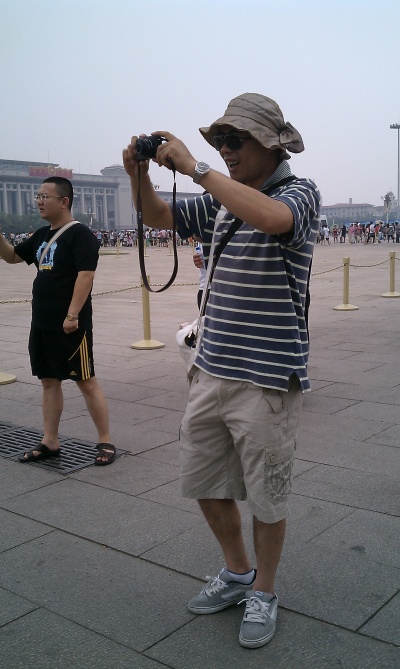 Tourists on the Square
Tourists on the Square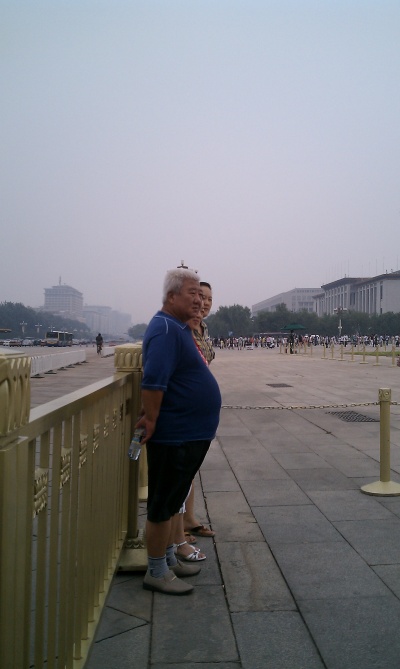 Posing in front of the Gate
Posing in front of the Gate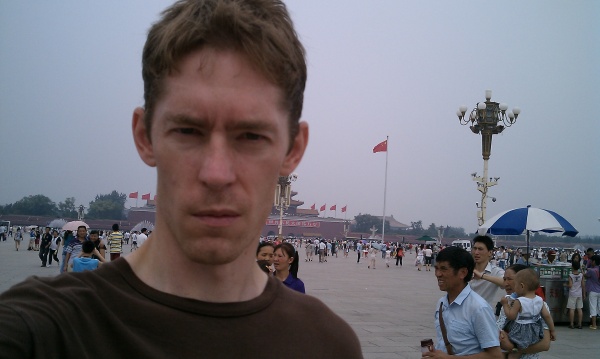 Do I look tired, or just out of focus?
Do I look tired, or just out of focus?
After resting a few minutes and taking a couple of pictures, I abandoned the square to walk to Wangfujing, one of Beijing’s most famous shopping streets. Along the way a couple people approached me and started conversations with me. They seemed to want to practice their English and ended up inviting me to somewhere to drink something. After Bill and Kirk’s misadventure in Shanghai last year, I am a little more wary about that sort of thing, and by this point I really was exhausted and just wanted to catch a train back to BLCU. I had walked for about 12 miles and my feet hurt. I grabbed a snack on the street and headed for the closest train station. The train trip back to the university took another hour. I shuffled slowly back to my dorm and grabbed a quick shower, getting off my feet for a couple hours before heading out with friends later that evening. It had been a great wandering, and I look forward to the next one.